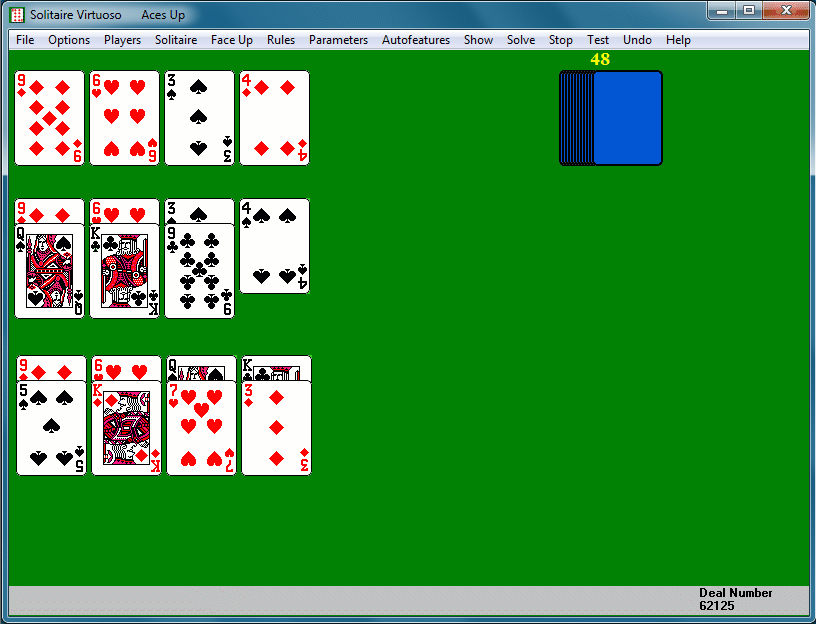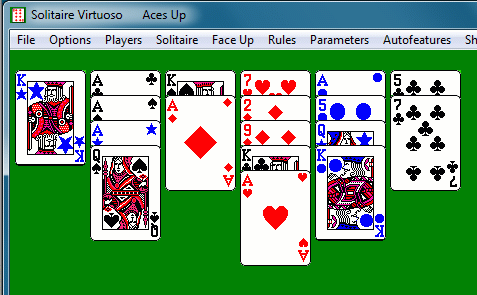
Aces Up and its Variations
A well-known traditional game, common in both print collections and computer implementations, is Aces Up, also known by other names such as Firing Squad, and Wheat and Chaff (so named in Games Digest, November 1938). It has also been called Idiot's Delight, but that name has been applied to so many different solitaires (and even solitaire in general) that it has become meaningless. The game starts with four cards being dealt from the stock to four tableau columns. If more than one card of the same suit appears, all but the highest ranking card of the suit can be discarded (aces rank high, above kings, and twos low). In a computer version, these discards could be made automatically, but I have never seen this option outside of the version I have developed for Solitaire Virtuoso. When all legal discards have been made, another card is dealt to each column. When every card has been discarded from a column, any uncovered card from another column can be played there. Let's see how this works. The deal below is number 62125 from the Solitaire Virtuoso program.

In the first set of cards, the four of diamonds
can be
discarded
because it is lower in rank than the nine. Four more cards
are dealt. (Some sources say that any empty columns
after the initial discards are filled individually, until there are
four cards of different suits. This is not correct. Spaces are part of
the game, and give the player a fighting chance). Now the four of
spades (queen) and nine of clubs can be discarded
(king), uncovering the three of spades which can also be discarded, and
the king and queen placed in the gaps (either order is
permitted). Then four more cards are dealt; this time only the
three of diamonds can be discarded. The win rate of the
standard game of Aces Up is only around 3 percent, and there are
relatively few decisions for the player to make. When a flash
(four cards of different suits) is dealt from the stock, no plays are
possible, and the cards can accumulate quickly on the tableau. This
happens often, since the frequency of a flash is 10.55%, so it
happens on average once or twice a deal. If the aces all
appear early, the player can often maneuver all of them to the bottoms
of their columns, only to get blocked by having a lower card dealt onto
the ace of its suit. Around 1992, Robert Roberds programmed
a DOS version (part of his series of BSX International solitaire games)
called AOTE (Aces of the Eno). He got around this problem by
declaring a win if the four columns were reduced to AAAA at any
time.
The Solitaire Virtuoso version has an option to automate both the discards and the dealing of new cards from the stock, pausing only when there are empty columns to allow the player to move selected card(s) into them. Even some of these plays may be automated at the player's option: when there is only one column with multiple cards, play into an empty column is automatic. Also, when there is at least one empty column, any column which contains cards all of the same suit can be reduced to one card.
How can we make the game better?
Variants have been devised to increase both the skill factor and the win rate. Pretty Good Solitaire includes the standard game, as well as a variant under the name Firing Squad (I really dislike the practice of using alternate names as standard names for variants, which only breeds confusion). In PGS, Firing Squad includes one freecell. Any card can be moved to the freecell, but the card in the freecell cannot be discarded or used to discard another card of the same suit; it can only be brought back from the freecell into an empty column. This rule increases the win rate to probably around 90% (a late flash can sometimes bring about a sudden defeat), at the expense of making the strategy rather mechanical: moving a lone card, often an ace, to the freecell and using the empty column to reduce other cards, then moving the ace back into another empty column is a technique which is too powerful -- almost like playing with five columns).
Solitaire King, a Windows 3.0 package of 31 games from 1995, includes a version of Aces Up which allows pairs of the same rank, except aces, to be removed, as well as the usual rule allowing removal of an uncovered card of a lower rank than another uncovered card of the same suit. Pairs must be removed in preference to lower cards of the same suit (this sometimes hurts the player, as it may not be the play desired). Solitaire King also has a variation which it calls Idiot's Delight, in which aces can be removed as pairs, and the object is to remove all 52 cards (this is a tricky variant; if aces are discarded too early, you can be stuck with a single card of a suit which cannot be removed). Solitaire King also provides the standard game as an option, which it calls Firing Squad (you can see already how confusion can set in with alternate names).
Randy Rasa programmed a shareware package in 1999 called Idiot's Delight, with four different variations. In addition to the standard (Hardest) version, which Rasa estimated at a 1 in 20 win rate, there is a Hard version where a card may be removed if the card directly below it is of the same suit and higher rank (he estimates this increases the win rate to 1 in 10) -- this is the overlap discard which we also see in variants of Nestor which are unrectified, and can also be used in Pyramid, Fourteen Out, Baroness, etc. There is also an Easy version where uncovered aces can be moved onto any other card except another ace (in addition to the Hard removal rule); the win rate is estimated at 1 in 4. In the Easiest version (1 in 2), pairs can be discarded. I do not know at present how much the rules allowing pairs to be discarded help in either Solitaire King or Idiot's Delight.
An entertaining version is Aces Up by Pogo Games (available for play online only, as part of the paid service Pogo's Club). This has a theme of World War I fighter pilots. There are two interesting rules here: each ace dealt can be moved (once) anywhere, even from occupied column to occupied column, and any ace which is moved to an empty column gives the player a Flying Ace, a picture of a pilot which can be used to remove any card later in the same deal (unused Flying Aces cannot be saved for the next deal, but allow the player to advance more rapidly to the next game rank). The special rules for aces increase the win rate to over 50 percent.
Five and six-suited decks
Aces Up is a somewhat better game with a deck of five or six suits (and dealt to five or six columns respectively). A five-suited deck reduces the odds of a flash to about 4.5%, and a six-suited deck to about 1.88%. A five-suited version under the name 5 Kings Up (credited there to John M. Feeney, with kings high and aces low) appeared in Dan Reed's 2001 program Solo, perhaps the first solitaire program allowing players to add their own games. This also seems to have disappeared from the Internet, though I still have a copy. I have now implemented options for up to eight suits (and columns) for the Solitaire Virtuoso program. The diagram below shows a sample six-suited deal, number 75848, which plays automatically to a blocked position with 18 cards left. It reaches a flash position quickly and no plays are possible except automatic discards and deals from the stock. The versions with more suits give the player more decisions to make, but there is even less hope of a win if the aces all come out early (the AOTE rule would work well here).

I also tried a double-deck version with eight columns and four
suits, with two aces of each suit. This actually doesn't
work well -- it is too easy, with a win rate probably over 99%.
So far I have found only one deal in several hundred tries, 61149,
which loses. Most deals play out automatically to a win with
Autoplay turned on, and few deals require more than one trivial click.
Baroness and Foxfire 13
A game distantly related to Aces Up is Baroness, also known
(boringly and not very descriptively) as Five Piles. This
is dealt in a manner similar to Aces Up, but with five columns instead
of four. Kings, and duos of cards adding to 13 (as in
Pyramid) may be discarded if they are uncovered. When
all possible (or desired) discards have been made, five new cards are
dealt and new discards made. The last two cards are turned over
separately as a reserve. Baroness is a game which blocks very easily, and
has an even lower win rate and skill factor than the standard Aces
Up. A better game can be played simply by increasing
the number of columns from five to six, or even
seven. But Todd Svec and Randy Rasa devised an
improved version called Foxfire 13 in 1994 for the House of Cards BBS,
by adding the Aces Up rule that any uncovered card can be moved to an
empty column. This was originally a DOS program,
later reprogrammed for Windows. An optional rule allowed a
card to be discarded if it was covering a higher card which made a pair adding to 13
(the overlap discard we mentioned earlier). Solitaire Virtuoso
includes Baroness, allows for variable numbers of columns, and
optionally permits overlap discards.
This article is copyright ©2021
by Michael Keller. All rights reserved. Most recently edited on April 12, 2021.